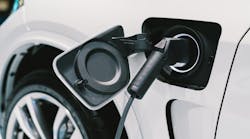First, the good news. Electric vehicle (EV) charging ports are on track to hit 18 million by 2027, according to the research firm Wood Mackenzie. Although most will be in homes, the residential share of the market will start to decline over the next three years as the public and commercial segments grow.
For electrical design firms, this ratio shift means a steady increase in business from shopping center developers, fleet owners, travel plaza chains, and other large companies. For electrical contractors, this trend could fatten profit margins because installing dozens of chargers at a single location incurs lower overhead costs than doing one-off residential jobs all over town.
The bad news is the hodge-podge of state and municipal regulations for installing EV chargers and uncertainty over how utilities can price electricity for the charging market. All of this creates complexity and inconsistency that often wreak havoc on schedules — not only for clients but also for contractors that need to move on to the next project to keep revenue flowing.
“It’s really problematic because you could be in one metropolitan area, and the cities or localities that make up that area could all have different requirements,” says Tammy Klein, Transport Energy Strategies founder and CEO. “That becomes very onerous, very costly, very confusing, and it really slows the development process.”
This problem scales up exponentially for design firms, contractors, and clients that operate across multiple metros and states. Just ask Love’s Travel Stops, which has more than 644 locations in 42 states.
“One AHJ has a certain specification on how they want things, and then sometimes an AHJ in the jurisdiction right next door has a different sort of requirement,” says Kim Okafor, general manager of zero emissions solutions at Trillium Energy Solutions, the Love’s subsidiary that builds and operates its EV charging infrastructure. “If you’re just working in one jurisdiction, that’s not a big deal. But if you’re like us, working in hundreds of jurisdictions, it adds complexity. It adds time. In some cases, it adds costs. It just makes it difficult to build out quickly.”
California leads the charge
In the process, state and local governments are undermining federal initiatives aimed at building out EV charging infrastructure quickly and widely. One example is the $5 billion for interstate charging networks through the National Electric Vehicle Infrastructure (NEVI) Formula Program.
“Each state is given the provision to build its own plan, and there’s a bit of inconsistency,” says Tom Bowen, president of Irvine, Calif.-based Qmerit Solutions, which partners with electrical contractors to provide charging station buildouts nationwide. “In a lot of ways, EV is still a bit of the Wild West when it comes to the infrastructure.”
This can limit business opportunities for electrical contractors that work in areas where regulations are inconsistent or incomplete.
“Charging networks are going for the path of least resistance in where they’re putting [equipment],” says Nick Esch, Wood Mackenzie research analyst.
That’s one reason why California has so many charging stations deployed or in the works.
“California has expedited processes for permitting public EV charging for Level 2 and DCFC,” says Amaiya Khardenavis, a Wood Mackenzie analyst who covers EV charging infrastructure. “That is why I think a lot of lot of stations are being put out in California pretty quickly compared to the others.”
Some design firms agree, such as Henderson Engineers, headquartered in Lenexa, Kan., which does a lot of projects in California.
“I would say they probably do one of the best jobs of detailing out a lot of those very specific requirements. They’re getting into not only where or how many EV stalls there needs to be, [but] also how many need to be installed on day one as opposed to just preparing for the future. They’re also looking at [ADA] accessibility of EV parking stalls,” says Clif Orcutt, electrical technical manager at Henderson Engineers. “If they’re not ahead of the curve, they’re where the curve should be, and everybody else is behind. A lot of states don’t have anything.”
The devil is in the details
Often the problem isn’t that state and local regulations create roadblocks by being onerous. Sometimes their vagueness (or even absence) can be just as problematic, such as when there’s no local code specifying how far EV chargers need to be from fuel pumps.
The Electric Vehicle Council’s Best Practice Guide for EVSE Regulations spotlights how some municipalities are providing the kind of detailed framework that helps speed design, installation, and approval. One example is the signage requirements in Kansas City, Mo.: “Information must be posted identifying voltage and amperage levels and any type of use, fees, or safety information related to the EVCS. A public EVCS must be posted with signage indicating that the space is reserved for EV-charging purposes only.”
According to Klein, the guide’s author and chairperson of the Electric Vehicle Council, you have cities that are faced with questions that they’ve really never had to contemplate.
“You might need to update your comprehensive plan, your zoning, your land-use codes,” she says. “Most developers, especially the retailers, actually may know more than the city does. And it’s not just cities; it’s counties, too.”
There is a nascent trend toward mitigating at least some local regulatory hurdles at the state level.
“California passed legislation to require streamlined permitting,” Klein says. “It’s like this set of requirements: ‘This is what you need to consider,’ and then you get your permit after a certain time. So, it’s like [municipalities] are not allowed to just sit on these things for months and months. New Jersey is [another] one that has enacted those kinds of requirements, but I think that’s something that we really need to see around the country. I don’t see sweeping, fast change, but I think there’s more recognition that that needs to happen.”
Until it does, contractors and their clients have to pad their schedules.
“The biggest challenge, the immediate one, is the various permitting requirements per jurisdiction,” says Qmerit’s Bowen. “We build a fair amount of time into our construction schedules to try to ensure that we can secure the permit in a timely fashion for [our] customers.”
Another workaround is going ahead and putting in at least some underlying infrastructure so chargers can be installed quickly later on.
“That’s what we started to do with our new truck stops a little over a year ago,” says Trillium’s Okafor. “We know we’re going to need it one day. We put in conduits. We set aside room in our switchgear.”
Demand charging helps drive BESS and solar demand
Some regulatory environments can create opportunities to upsell clients on solar and battery energy storage systems (BESSs). One example is when the local utility doesn’t have enough capacity to fully support, say, a fleet owner’s plan to deploy chargers as part of a transition to EVs. If that means building a substation, the utility must run its own permit gauntlet. Add in the shortage of equipment such as switchgear, and the whole process can take 12 to 18 months.
“We’re seeing people evaluating batteries as the way to quickly get to market,” says Niraj Shetty, a Black & Veatch principal who specializes in EV planning and strategy. “It helps solve the problem of not being able to get utility energy quickly.”
Some state laws allow utilities to vary their rates based on demand. This can drive up overhead costs for businesses, such as fleet owners.
“The clients we have are ones that have very specific time-of-day processes that don’t want to get affected when switching to EVs,” says Henderson’s Orcutt. “They don’t want to have a delay in anything, so they are looking for all of that electric load to come at a specific time in a 24-hour cycle. Unfortunately, that tends to coincide when people are home and charging their own vehicles, using their ovens and air conditioning, and whatnot. So, that’s becoming the bigger issue from what I’ve seen.”
This issue is helping drive interest in BESSs among public charging providers, too. One example is travel stop operators, which could use it to avoid the need to increase prices across the board or by time of day.
“Battery storage is an option that helps smooth out the curve and provides more predictability,” Okafor says. “The difficulty there is that battery storage is additional capital investment on an economic case that’s already difficult. So the question that we ask ourselves is, should we wait for utilization to grow to invest more in these stations, or should we add all that capital now? That’s really the balancing act. I think batteries and even on-site power generation are going to play a part in this market.”
Another factor with a BESS is that it can trigger additional site requirements in some cities and states.
“There have been battery fires, and that has created some very strict additional code requirements — particularly in California and New York — like you’ve got to have a big brick wall between the storage [and fuel pumps] or other mitigating factors,” says Paul Stith, Black & Veatch associate vice president for global transportation initiatives.
In other cases, a city might require brick walls to shield big BESS units from public view, such as when the charging station backs to a neighborhood. This also highlights how local aesthetic and safety requirements alike can affect a project’s budget — or scuttle a site altogether.
“If this is the sole site that they have, and it really needs to go forward, then they need to figure that out,” Shetty says. “If it is a programmatic operator or chain or somebody that has multiple locations, it could very much sway that they don’t pick that particular site. I’ve seen that, for sure.”
Sometimes solar can make a site viable for fleet owners, truck stops, and other power users.
“When you’ve got such large loads, those same clients are talking about, ‘What can we do as far as on-site power production to not be so reliant on the utility?’” Orcutt says. “That’s kind of a discussion that’s being had in parallel instead of thinking about it after the fact.”
“That’s definitely microgrid territory. When you’re getting into your own power production to offset your own power needs rather than relying on a utility because for whatever reason — the utility can’t provide that power at a certain time of day or they’re unreliable or you want the redundancy — that’s becoming the bigger need for our clients rather than just that traditional model of ‘I’ll add more load, and the utility will be able to supply it.’”
Finally, regulatory complexity and uncertainty can give some contractors and design firms a competitive edge. One example is being able to expedite a project because the firm already has experience with that jurisdiction’s requirements and preferences. Another example is showing cities and counties with little or no EV charging experience how they can adopt what works in other communities. That can help fast track installations, such as a travel plaza on a rural interstate.
“Because we’ve done so many sites, in many instances, we’re the first one ever to bring EV charging to a jurisdiction,” says Black & Veatch’s Stith. “One of the key provisions in the regulatory side of this is ADA-accessible facilities. In different jurisdictions, they will need to get clarity about how many stalls need to be accessible, wheelchair ramps, and so forth. It gets pretty tricky, but that’s one of the things that our site-acquisition specialists really help our clients navigate: What are best practices? Even if it’s not code yet, it probably will become code.”
Tim Kridel is an independent analyst and freelance writer. He can be reached at [email protected].




